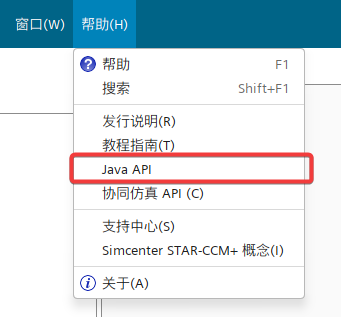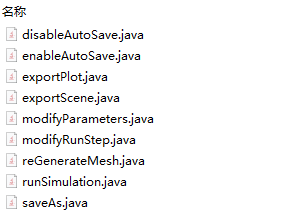STAR-CCM+宏本质上就是一个java文件,语法和普通的java没有什么区别。使用宏可以帮助我们简化处理过程,尤其是一些重复的流程性的操作。通过编写宏文件完成一些流程操作可以极大地解放人力资源,甚至可以在求解过程中完成某些特定的操作。
1. 录制宏
STAR-CCM+宏本质就是分析过程中的各种操作命令的集合,与其从头开始讲解复杂繁琐的java语法+API,不如直接从工程问题上手。
STAR-CCM+宏操作的入口在左上角工具栏里,从左到右依次是“播放宏”、“开始录制”、“暂停录制”和“停止录制”按钮,相关操作选项也可以在“文件”菜单中找到。

点击“开始录制”会弹出对话框,提示宏的保存位置。如果过程中用到一些场景化的图形操作,可以勾选上“包括图形命令”;但一般情况下不建议勾选,尤其是涉及到超算提交的场合。

接下来就可以在输出窗口中看到录制java过程的代码,此时可以正常地执行分析操作,STAR-CCM+会把相关操作转换成对应的java代码,并显示在输出窗口中。

当分析操作完成后点击“停止录制”,可以在输出窗口中看到完整的java代码,同时该代码也被保存到java文件中。
下面是录制的宏代码示例,作用是将原有网格清除并重新划分体网格。
// Simcenter STAR-CCM+ macro: reGenerateMesh.java
// Written by Simcenter STAR-CCM+ 19.06.009
// 上面两行注释是录制时生成的,记录保存宏的文件名、STAR-CCM+版本信息
package macro;
import java.util.*;
import star.common.*;
import star.meshing.*;
// 类名和文件名要一致
public class reGenerateMesh extends StarMacro {
//这个函数是整个宏的入口
public void execute() {
execute0();
}
//这个函数执行网格清除和划分操作
private void execute0() {
Simulation simulation_0 =
getActiveSimulation();
MeshPipelineController meshPipelineController_0 =
simulation_0.get(MeshPipelineController.class);
//清除原来的网格
meshPipelineController_0.clearGeneratedMeshes();
//生成体网格
meshPipelineController_0.generateVolumeMesh();
}
}
具体代码的作用可以查看STAR-CCM+的帮助文件,不过大部分的API的命名都比较直观,根据其命名也能推测出来。

如果要执行的操作比较复杂,流程很多。建议将流程进行分解,分别录制不同java文件,再将其组合起来。

如果录制的操作需要运行求解器,可以换一个简单点的模型进行录制,也可以把参数调小一点,节省时间和资源。
2. 编写宏
有了上面录制的java文件,下面的编写就简单多了。
接下来将这些模块组合起来,编写一个新的java宏文件,作用是在读取sim文件之后自动划分网格,设置参数并运行求解,求解完成后输出相应的绘图和场景文件,并保存成指定文件名的结果文件。
这里建议使用IDE工具,借助语法检查、代码高亮提示和自动完成可以减少出错的几率,对初学者十分友好。STAR-CCM+官方教程和帮助文件里演示的是NetBeans,也有人喜欢用Eclipse或IntelliJ IDEA,在这里区别都不大,根据个人喜好选择吧。
// Simcenter STAR-CCM+ macro: meshAndRun.java
// Written by Simcenter STAR-CCM+ 19.06.009
package macro;
import java.util.*;
import star.common.*;
import star.meshing.*;
import star.base.neo.*;
import star.vis.*;
public class meshAndRun extends StarMacro {
// 分析的输入参数
double env_temp = 25.0; // Unit: C
double fan_speed = 2450.0; // Unit: rpm
// 一些设置参数
boolean autoSave = true;
int maxStep = 10;
int autoSaveStep = 1000;
boolean saveAsResultsFile = true;
// 这里最好写完整路径,否则Windows下会默认保存到${HOME}目录
String resultsFileName = "final_results.sim";
// 宏操作入口
public void execute() {
// 执行分析操作
if (autoSave) {
enableAutoSave();
} else {
disableAutoSave();
}
generateMesh();
modifyParameters();
modifyMaxStep();
run();
exportPlot();
exportScene();
if (saveAsResultsFile) {
saveAs();
}
}
// 生成体网格
private void generateMesh() {
Simulation simulation_0 = getActiveSimulation();
MeshPipelineController meshPipelineController_0 = simulation_0.get(MeshPipelineController.class);
// meshPipelineController_0.clearGeneratedMeshes();
meshPipelineController_0.generateVolumeMesh();
}
// 设置自动保存
private void enableAutoSave() {
Simulation simulation_0 = getActiveSimulation();
AutoSave autoSave_0 = simulation_0.getSimulationIterator().getAutoSave();
autoSave_0.setAutoSaveBatch(true);
autoSave_0.setAutoSaveMesh(true);
AutoSaveFileSet autoSaveFileSet_0 = ((AutoSaveFileSet) autoSave_0.getAutoSaveFileSetManager()
.getObject("Auto Save File Set 1"));
StarUpdate starUpdate_0 = autoSaveFileSet_0.getStarUpdate();
IterationUpdateFrequency iterationUpdateFrequency_0 = starUpdate_0.getIterationUpdateFrequency();
IntegerValue integerValue_0 = iterationUpdateFrequency_0.getIterationFrequencyQuantity();
integerValue_0.getQuantity().setValue(autoSaveStep);
starUpdate_0.setEnabled(true);
}
// 取消自动保存
private void disableAutoSave() {
Simulation simulation_0 = getActiveSimulation();
AutoSave autoSave_0 = simulation_0.getSimulationIterator().getAutoSave();
autoSave_0.setAutoSaveMesh(false);
autoSave_0.setAutoSaveBatch(false);
}
// 设置分析的输入参数
private void modifyParameters() {
Simulation simulation_0 = getActiveSimulation();
ScalarGlobalParameter scalarGlobalParameter_0 = ((ScalarGlobalParameter) simulation_0
.get(GlobalParameterManager.class).getObject("env_temp"));
Units units_0 = ((Units) simulation_0.getUnitsManager().getObject("C"));
scalarGlobalParameter_0.getQuantity().setValueAndUnits(env_temp, units_0);
ScalarGlobalParameter scalarGlobalParameter_1 = ((ScalarGlobalParameter) simulation_0
.get(GlobalParameterManager.class).getObject("fan_speed"));
Units units_1 = ((Units) simulation_0.getUnitsManager().getObject("rpm"));
scalarGlobalParameter_1.getQuantity().setValueAndUnits(fan_speed, units_1);
}
// 设置最大步数
private void modifyMaxStep() {
Simulation simulation_0 = getActiveSimulation();
StepStoppingCriterion stepStoppingCriterion_0 = ((StepStoppingCriterion) simulation_0
.getSolverStoppingCriterionManager().getSolverStoppingCriterion("Maximum Steps"));
IntegerValue integerValue_0 = stepStoppingCriterion_0.getMaximumNumberStepsObject();
integerValue_0.getQuantity().setValue(maxStep);
}
// 运行求解器
private void run() {
Simulation simulation_0 = getActiveSimulation();
// ResidualPlot residualPlot_0 = ((ResidualPlot)
// simulation_0.getPlotManager().getPlot("Residuals"));
// residualPlot_0.openInteractive();
simulation_0.getSimulationIterator().run();
}
// 输出绘图
private void exportPlot() {
Simulation simulation_0 = getActiveSimulation();
MonitorPlot monitorPlot_0 = ((MonitorPlot) simulation_0.getPlotManager().getPlot("mass_flow"));
// 这里可以用相对路径,也可以用绝对路径
monitorPlot_0.export(resolvePath("mass_flow.csv"), ",");
}
// 输出场景
private void exportScene() {
Simulation simulation_0 = getActiveSimulation();
Scene scene_0 = simulation_0.getSceneManager().getScene("Geometry");
scene_0.export3DSceneFileAndWait(resolvePath("Geometry.sce"), "Geometry", "", false, SceneFileCompressionLevel.OFF);
}
// 保存结果
private void saveAs() {
Simulation simulation_0 = getActiveSimulation();
simulation_0.saveState(resultsFileName);
}
}
3. 运行宏
编写完成后可以尝试运行以下,看看有没有报错。 尝试运行求解的话可以把求解步数调小一点,看输出的文件是否正确。 更改条件和参数,多测试几次,经过完整测试没有报错才可以用于生产环境。
如果要提交超算运行,应在-batch开关后附加java宏文件路径1。
starccm+ [path-to-sim-file] -batch [path-to-java-file] -np [number-of-threads] ...
